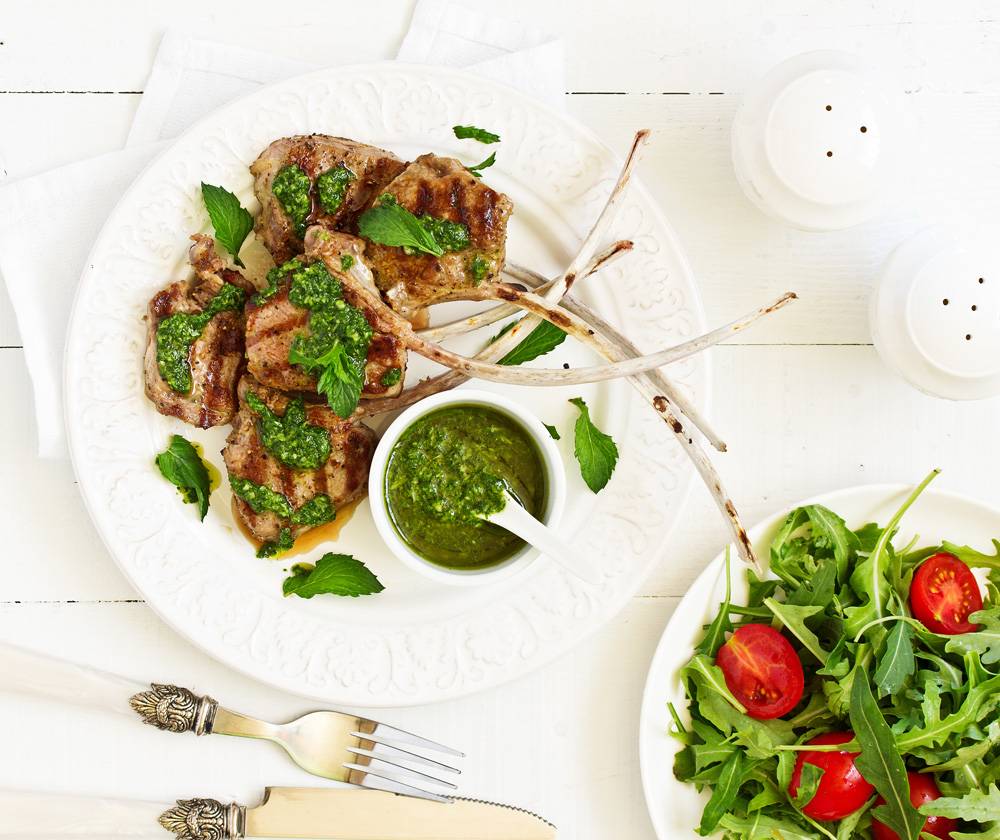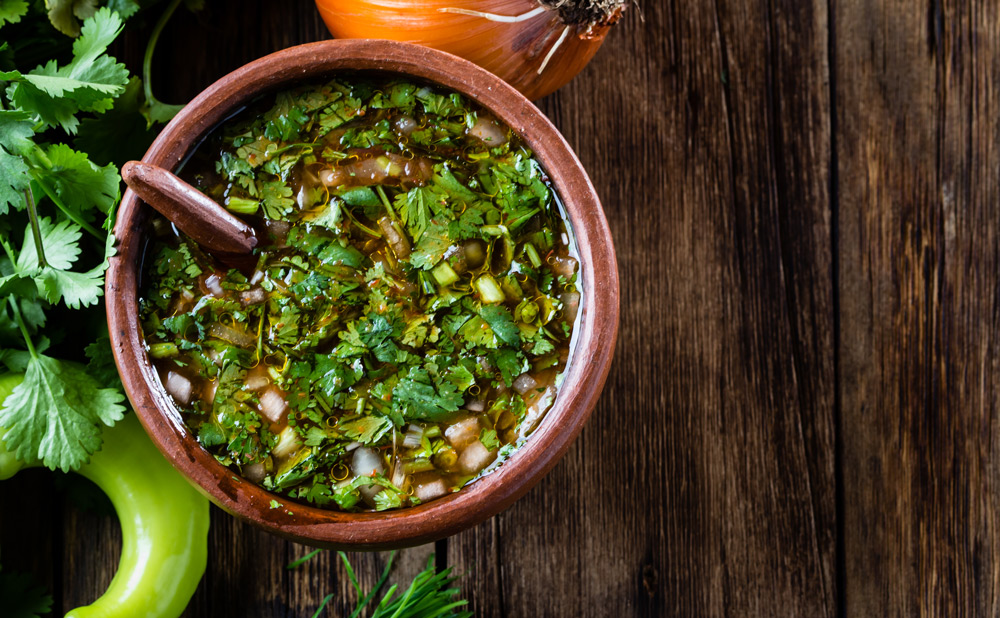Lamb Loin Chops with Lemon-Mint Gremolata, Spotlight on Gremolata, Why Proteins Need to Rest, Secrets of the World’s Healthiest Country, and Exercise for Your Brain
Lamb is finally having its moment in American cuisine. Many of us didn’t grow up eating lamb, so if you’ve never tried it, you may just think you don’t like it. Or if you’ve only known it as a special occasion or holiday dish, it might not occur to you to shop for it on a regular basis. But lamb has a mild, tender taste that meat eaters will love, and loin or shoulder chops are perfect for the grill any day of the year. Salt, pepper, and a quick rub with extra virgin olive oil, and you’re set to go.
Lamb Loin Chops with Lemon-Mint Gremolata
 Lamb Loin Chops with Lemon-Mint Gremolata
Lamb Loin Chops with Lemon-Mint GremolataLamb is finally having its moment in American cuisine. Many of us didn’t grow up eating lamb, so if you’ve never tried it, you may just think you don’t like it. Or if you’ve only known it as a special occasion or holiday dish, it might not occur to you to shop for it on a regular basis. But lamb has a mild, tender taste that meat eaters will love, and loin or shoulder chops are perfect for the grill any day of the year. Salt, pepper, and a quick rub with extra virgin olive oil, and you’re set to go.
Ingredients
- 2 garlic cloves, peeled and roughly chopped
- 1/4 cup fresh mint leaves
- 1/4 cup fresh flat-leaf parsley leaves
- Zest of 1 lemon
- 2 tablespoons fresh lemon juice
- 1/4 cup shelled hazelnuts
- 1/4 cup extra virgin olive oil, plus extra for brushing on the lamb chops
- Kosher salt to taste
- Coarsely ground black pepper to taste
- 8 lamb loin chops
Directions
Step 1
Make the gremolata: In a blender or mini food processor, combine the garlic, mint, parsley, lemon zest and juice, and hazelnuts. Pulse several times, and then slowly add the 1/4 cup of olive oil. Process until relatively smooth. If the mixture seems stiff, add a small amount of water. Season with salt and pepper. Reserve.
Step 2
Preheat your grill to medium-high. Brush the lamb chops on both sides with olive oil, and season well with salt and pepper. Grill for 2 to 3 minutes per side for medium-rare. After letting chops rest for 5 minutes, plate two chops per person with a healthy dollop of the gremolata and pass the rest.
Yields 4 servings.

Healthy Ingredient Spotlight
The Greatness of Gremolata
If you’re a sauce maven like me, you need gremolata in your repertoire. Traditionally used as a garnish for osso buco, the slow-braised veal shank dish from the Lombardy region, this classic Italian mixture is a masterful garnish for all types of foods, from grilled meat, chicken, and fish to roasted vegetables and creamy soups. Always use the freshest parsley, mint, and garlic, and make it as close to mealtime as possible for the best flavor.

Healthy Kitchen Nugget
Why Proteins Need to Rest
I always say it about grilled meats, but the same goes for roasts: Proteins need to rest and redistribute their juices before you cut into them. Otherwise, those juices will pour out—and will often be lost—as you make your first slice. Of course, this is more essential, and the rest time is longer, for a large flank steak than for individual lamb chops. Keep in mind that during this time out of the oven or off the grill, the food continues to cook, and its internal temperature will rise anywhere from a few degrees in a small portion of meat to 10 or 15 degrees in a turkey. Consider these additional degrees when testing food with your instant-read thermometer, and take it off the heat source accordingly, to avoid going beyond the level of doneness you desire.

For Your Best Health
Secrets of the World’s Healthiest Country
Members of the Fresh-Pressed Olive Oil Club know that I’ve been working with artisanal olive growers in Spain for my extra virgin olive oil since 2005. Olive oil courses through daily life in Spanish towns—when people hear you are interested in olive oil, they brighten, invariably promising to put you in touch with their cousin or neighbor who grows olives. Olive oil is such an integral part of the Mediterranean diet of healthy fats, legumes, fruits, and vegetables, which Spaniards elevate to great heights with their fabulous cuisine. So it was no surprise to me when Spain ranked #1 in the last Bloomberg Global Health Index report.
The index uses a group of factors to rank the countries of the world on a scale from 0 to 100, with 100 being the ideal. The factors are life expectancy, malnutrition, causes of death, the availability of clean water, and health risks like tobacco use, high blood pressure, and obesity. With a score of 92.75, Spain took top honors. It boasts a life expectancy projected to rise to 85.8 years by 2040—the highest in the world. In addition to its signature healthy diet, Spain is also a country of walkers, which is so great for fitness. And guess what country came in second? Its close neighbor on the other side of the Mediterranean: Italy!

Fitness Flash
Exercise: Good for the Mind
A recent report in ACSM’s Health & Fitness Journal crystallized what health experts have been saying for years: Beyond its benefits for physical health, exercise is great for mental health, with both short- and long-term advantages. Across your life span, the more you engage in physical activity, the more you can reduce the risk of depression and anxiety, two crippling mental illnesses. And should you develop one of these issues, the cumulative effects of regular exercise can help you cope better.
Just having a bad day? An exercise session can get you out of a blue mood and defuse anger, stress, and tension. Get in a brisk walk at lunch, and you may find that you have better concentration and renewed enthusiasm in the afternoon.
Scientists don’t have a magic formula for the type, intensity, or length of a mental health-boosting workout, but that’s not really a problem. Sticking with a workout plan is what’s most important, and the secret to doing that is to go with your individual preferences—there’s no point in forcing yourself to run for five miles if what you really like to do is play tennis. Know that mind-body exercises like yoga, tai chi, and qigong can improve symptoms of depression and anxiety as well as other forms of exercise do, and put together a menu of choices that appeal to you. Even though fitness guidelines for heart health look at weekly totals—150 minutes of moderate-intensity or 75 minutes of vigorous-intensity aerobic exercise per week (plus resistance and flexibility exercises), the more you can spread out those minutes, the better: 10 to 20 minutes each and (almost) every day is most helpful to regulate mood.
Get More Recipes In Your Inbox!


